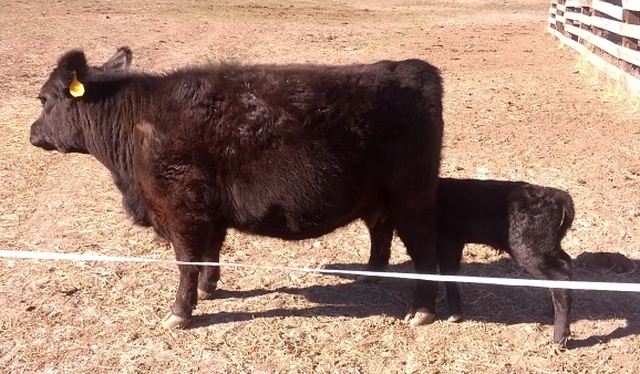There’s something to be said for experience. This is truly applicable to cows. The frustration of heifers is something I seem to go through every year. Even if there are no issues, I fret about what issues could come up.
Heifers don’t know what the heck they are doing. They jump all over each other, even if none are in heat. Then they go into labor and have no idea what is going on. A calf comes out and they look at it like it’s an alien. As to being a mom, keeping track of their baby seems to be a common issue for them. Crazy heifers.

Lilly with her first calf, Trouble. She is a great mom.
I much prefer cows that are on their second calf. They’ve had a calf, they know what is happening, they know what is going on, and they are much more prepared to take care of that calf.
Here are a few things to help heifers be successful with their first calf and to become better cows.
It is common practice to breed heifers so that they will calve before the cows, giving producers more time to dedicate to the heifers. While it sounds like a good idea, I’ve found that if the heifers are actually bred to calve either with the cows (at least one cow calving before the heifers) or after the cows, the heifers do better. They learn from the cows. Seriously.
Our first couple cows that calve have quite the audience. If the heifers could write, they would be frantically scribbling notes. The results: the heifers aren’t so alarmed when they start into labor, end up with a calf coming out of them, and know exactly what they are supposed to do with a calf.
A few of our cows have actually learned to roll their calf, butting it repeatedly when it is trying to stand up for the first time. It’s quite alarming, actually, but it makes sense. Every time the calf gets knocked down, it gets up faster the next time. This was a learned behavior from a single cow.
My next suggestion, leave the calf alone and keep other heifers and cows away from it. Give the heifer plenty of time–days if possible–to bond with her calf. She’ll bring it into the herd when she is ready. If too soon, or the heifer leaves her calf too soon, we have had a problem with other cows or heifers trying to adopt the calf; generally before the adoptive female has had her calf. Tag (and weigh, if you do that) the baby, then leave; if you can’t get it tagged because the heifer won’t let you near it, let it be. You can tag the baby in the chute later.
Finally, because heifers are still growing and trying to raise a calf, make sure they have plenty of good quality feed. I’m not saying dairy-quality alfalfa, but if you are able to give them better feed than the rest of the cows, they could use the higher plane of nutrition. Moving them into the next paddock earlier than the cows–forward grazing–gives them the choice of the best. Making sure the heifer stays in condition gives her a better chance of breeding back on time and having a good calf at weaning. Also, in my experience, a heifer that keeps her condition during her first calf is going to keep her condition more easily throughout her life.
Letting the heifers run with the cows also teaches them what to eat and what to mix so that they meet their needs. Ironically, cows will also learn from heifers. Because heifers will try new things, they will teach the cows to eat plants they had not eaten before.
I’ll take a 2nd calf heifer over a 1st calf heifer most any day of the week. At least with the above practices, we’ve improved our heifers’ mothering abilities and ended up with some great cows.
Do you have anything that helps heifers be better cows? Please leave suggestions and experience below!



